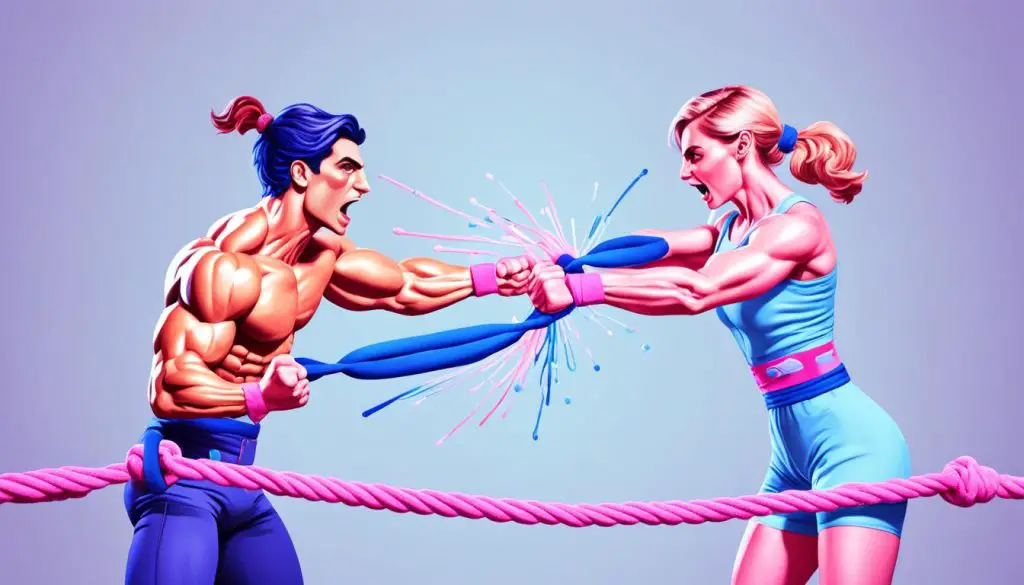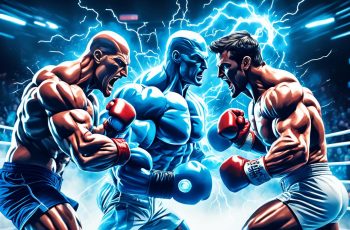Ad Blocker Detected
Our website is made possible by displaying online advertisements to our visitors. Please consider supporting us by disabling your ad blocker.
Have you ever wondered whether estrogen or testosterone is responsible for boosting your libido? The influence of hormones on sexual desire is a fascinating topic that has intrigued researchers for years. Understanding the role of estrogen and testosterone in libido can provide valuable insights into sexual health and help address concerns related to low sexual desire. Let’s explore the effects of these hormones on sex drive and the impact of hormonal changes on libido.
Key Takeaways:
- Both estrogen and testosterone play a role in modulating sexual desire in women, but estrogen, specifically estradiol, seems to be the primary hormone involved.
- Estrogen-only therapies that produce periovulatory levels of estradiol have been shown to increase sexual desire in postmenopausal women.
- Testosterone, when combined with low-dose estrogen therapy, can enhance the effectiveness of increasing sexual desire in women, although the exact mechanism is still unknown.
- Hormonal changes, such as menopause or surgical menopause, can lead to a decrease in sexual desire due to diminished levels of estrogen, testosterone, and progesterone.
- Pharmaceutical companies have focused on developing androgen therapies for female sexual desire disorders, but there are currently no FDA approved therapies for women.
The Discovery of Testosterone and its Early Uses in Women
In 1889, Charles Brown-Séquard presented the results of his auto-experimentation with testicular fluids, claiming health improvements from his injections. This sparked international interest in the power of testicular fluids and eventually led to the isolation and synthesis of testosterone in 1935.
Testosterone therapy was initially prescribed for various medical conditions, including menstrual complaints and as a tumor suppressant in advanced breast cancer. Some women treated with high-dose testosterone therapies reported an increase in sexual desire, but these doses also led to somatic virilization.
The use of testosterone therapy in women is still a topic of debate and off-label prescription, with the idea of testosterone as a cure-all for female sexual dysfunction remaining popular.
| Year | Discovery/Development | Early Uses in Women |
|---|---|---|
| 1889 | Charles Brown-Séquard presents auto-experimentation results | No specific use in women known |
| 1935 | Testosterone isolated and synthesized | Prescribed for menstrual complaints and as a tumor suppressant in advanced breast cancer |
The Role of Estrogen in Female Sexual Function
Estrogen, specifically estradiol, plays a crucial role in women’s sexual function. It is the main female hormone responsible for triggering puberty, the development of secondary sex characteristics, regulating the reproductive cycle, and supporting bone health.
Studies have shown that estrogen levels can significantly impact sexual desire in women. Low levels of estrogen have been associated with decreased libido, while therapies that increase estrogen levels have been found to improve sexual desire.
One notable therapy is estrogen-only therapy, which produces periovulatory levels of circulating estradiol. This type of therapy has been shown to increase sexual desire in postmenopausal women, where estrogen levels naturally decline. By replenishing estrogen levels, women may experience a boost in their sexual desire.
Estrogen deficiency during menopause can lead to a decrease in sexual desire for many women. Besides affecting libido, low estrogen levels can also cause other sexual health issues such as vaginal dryness, pain during intercourse, and weight fluctuations.
“Estrogen, specifically estradiol, plays a crucial role in women’s sexual function.”
Understanding the impact of estrogen on sexual function is essential for addressing sexual concerns in women. By maintaining appropriate estrogen levels, women can improve their sexual desire and overall sexual well-being.
Potential Benefits of Estrogen Therapy for Sexual Function
Estrogen therapy, when prescribed appropriately, may offer the following benefits for female sexual function:
- Increased sexual desire
- Improved lubrication
- Reduced pain during intercourse
- Enhanced overall sexual satisfaction
Therefore, estrogen therapy can be a valuable option for women experiencing sexual concerns due to low estrogen levels.
| Estrogen’s Impact on Sexual Desire | Effects |
|---|---|
| Increased estrogen levels | Higher sexual desire |
| Decreased estrogen levels | Lower sexual desire |
The table above illustrates how estrogen levels can impact sexual desire. When estrogen levels are increased, sexual desire tends to be higher. On the other hand, decreased estrogen levels are often associated with lower sexual desire.
By addressing estrogen imbalances and ensuring adequate levels, women can potentially improve their sexual desire and overall sexual satisfaction.
The Role of Testosterone in Female Sexual Function
Testosterone, primarily found in males but also produced in small amounts by females, plays a crucial role in sustaining libido and regulating sperm production in both sexes. Numerous studies have linked testosterone levels to sexual desire and arousal, shedding light on its significant impact on sexual function.
Despite being primarily associated with male physiology, testosterone therapy has also been prescribed off-label for the treatment of low sexual desire in women. However, it is important to note that there are currently no FDA approved androgen therapies specifically designed for women.
Research indicates that supraphysiological levels of testosterone, when combined with low-dose estrogen therapy, can enhance the effectiveness of increasing sexual desire in postmenopausal women. The exact mechanism by which supraphysiological testosterone increases sexual desire in combination with estrogen remains unknown and requires further investigation.
The Interplay between Testosterone and Estrogen
Testosterone and estrogen work together to regulate various aspects of sexual function. While estrogen is primarily responsible for triggering puberty, supporting bone health, and regulating the reproductive cycle, testosterone plays a vital role in sustaining libido and influencing sexual desire.
In postmenopausal women, estrogen levels decline, leading to a decrease in sexual desire. At the same time, lower levels of testosterone may also contribute to the decline in libido. The use of low-dose estrogen therapy combined with supraphysiological levels of testosterone has shown promise in increasing sexual desire in this population.
However, it is essential to note that the use of testosterone therapy in women is still a topic of debate. The effectiveness and long-term safety of testosterone therapy in women require further research and clinical trials.
Testosterone Therapy for Women: A Controversial Approach
The idea of using testosterone therapy to treat low sexual desire in women remains controversial. While some women may experience an improvement in sexual desire with testosterone therapy, there are concerns about the potential risks and side effects, including virilization, acne, and voice deepening.
“The focus of pharmaceutical companies on the development of androgen therapies for female sexual desire disorders may be misplaced. Effective therapies require supraphysiological amounts of testosterone, posing potential risks.”
At present, there are no FDA approved androgen therapies specifically developed for women, highlighting the need for further research and regulation in this area. It is crucial to consult with healthcare professionals experienced in hormone therapy to assess the potential benefits and risks before considering testosterone therapy for low sexual desire.

Hormonal Changes and Sexual Desire in Women
As women undergo hormonal changes, particularly during natural or surgical menopause, their sexual desire may decrease. These changes are attributed to the cessation of ovarian function, which leads to diminished levels of ovarian steroids such as estradiol, testosterone, and progesterone. The decline in these hormones is often accompanied by a decline in sexual desire.
Postmenopausal women who have undergone bilateral oophorectomy, the surgical removal of ovaries, commonly report a decrease in sexual desire. This decrease can be attributed to the drop in circulating levels of ovarian steroids. The role of these hormones in regulating sexual desire in women has been extensively studied.

One way to address the decline in sexual desire associated with menopause is through estrogen-only therapies that produce periovulatory levels of circulating estradiol. Studies have shown that these therapies can increase sexual desire in postmenopausal women.
Understanding the impact of hormonal changes on sexual desire is crucial in developing effective interventions for women experiencing reduced libido due to hormonal fluctuations. Further research is needed to delve deeper into the intricate interplay between hormonal changes and sexual desire in women.
The Debate on Hormonal Modulation of Women’s Sexual Desire
The debate surrounding the hormonal modulation of women’s sexual desire revolves around the roles of estrogen and testosterone. While both hormones have been implicated in the regulation of sexual desire in women, evidence from other female mammals suggests that only estradiol is critical in this process. Pharmaceutical companies have made significant investments in the development of androgen therapies for female sexual desire disorders, but as of now, there are no FDA-approved androgen therapies specifically designed for women. Off-label prescriptions of testosterone are often used to treat low sexual desire; however, the effectiveness and precise mechanism of action of this hormone remain unclear.
The ongoing focus on androgen therapies for female sexual desire disorders may be misplaced, as effective treatments would require supraphysiological amounts of testosterone. It is crucial to conduct further research to fully comprehend the hormonal influence on women’s sexual desire and determine the most appropriate treatment options.
Contrasting Effects of Estrogen and Testosterone
| Estrogen | Testosterone |
|---|---|
| Positive Effects: | Positive Effects: |
| Increased sexual desire in postmenopausal women when administered as estrogen-only therapies producing periovulatory levels of circulating estradiol. | Enhances the effectiveness of low-dose estrogen therapies in increasing sexual desire in postmenopausal women when used at supraphysiological levels. |
| Negative Effects: | Negative Effects: |
| None reported. | May lead to somatic virilization when used at high doses. |
While estrogen demonstrates positive effects on sexual desire in postmenopausal women, testosterone supplementation requires high doses beyond physiological levels to achieve similar results. The potential negative effects of high-dose testosterone therapy, such as somatic virilization, raise concerns regarding its widespread use as a treatment for female sexual desire disorders. It is essential to consider and explore alternative approaches for addressing hormonal modulation of sexual desire in women.
Conclusion
The debate on whether estrogen or testosterone plays a more significant role in boosting libido in women continues. Both hormones have been implicated in modulating sexual desire. However, the evidence suggests that estrogen, specifically estradiol, may be the more likely candidate.
Estrogen-only therapies that produce periovulatory levels of circulating estradiol have been shown to increase sexual desire in postmenopausal women. Additionally, testosterone, when administered at supraphysiological levels, can enhance the effectiveness of low-dose estrogen therapies in increasing sexual desire. However, the exact mechanism behind this interaction remains unknown, and the contribution of endogenous testosterone to women’s sexual desire modulation is uncertain.
It is important to note that while testosterone is frequently prescribed off-label for the treatment of low sexual desire in women, there are currently no FDA approved androgen therapies specifically tailored for women. This suggests that the focus of pharmaceutical companies on the development of androgen therapies for female sexual desire disorders may be misplaced.
Further research is needed to fully understand the hormonal influence on female sexual desire. As we continue to learn more, it is essential to explore and identify effective therapies that address the complex interplay between estrogen, testosterone, and other factors impacting women’s sexual desire.
FAQ
Does estrogen or testosterone make you hornier?
Both estrogen and testosterone have been implicated in modulating sexual desire in women. Estrogen, specifically estradiol, seems to play a more significant role in boosting libido. Testosterone, at supraphysiological levels, can enhance the effectiveness of low-dose estrogen therapies in increasing sexual desire.
What is the influence of hormones on libido?
Hormones, such as estrogen and testosterone, have a significant impact on sexual desire in women. Estrogen, particularly estradiol, is responsible for triggering puberty, regulating the reproductive cycle, and supporting bone health. Testosterone, primarily found in males but also produced in small amounts by females, plays a role in sustaining libido and regulating sperm production in both sexes.
What are the effects of estrogen on sex drive?
Estrogen, specifically estradiol, is critical for triggering puberty, development of secondary sex characteristics, regulating the reproductive cycle, and supporting bone health. Studies have shown that low levels of estrogen are associated with decreased sexual desire in women. Estrogen-only therapies that produce periovulatory levels of circulating estradiol have been shown to increase sexual desire in postmenopausal women.
What are the effects of testosterone on sex drive?
Testosterone, primarily found in males but also produced in small amounts by females, plays a role in sustaining libido and regulating sperm production in both sexes. Testosterone therapy has been prescribed off-label for the treatment of low sexual desire in women. Testosterone, when combined with low-dose estrogen therapy, has been shown to enhance the effectiveness of increasing sexual desire in postmenopausal women.
How do hormonal changes affect horniness?
Hormonal changes, such as the cessation of ovarian function during menopause, can lead to a decrease in sexual desire in women. Diminished levels of ovarian steroids, including estradiol and testosterone, are accompanied by a decline in sexual desire. Postmenopausal women who undergo bilateral oophorectomy, the surgical removal of ovaries, often report a decrease in sexual desire due to a drop in circulating levels of ovarian steroids.
How do estrogen and testosterone impact libido?
Estrogen, specifically estradiol, is critical for modulating sexual desire in women. Testosterone, when combined with estrogen therapy, can enhance the effectiveness of increasing sexual desire in postmenopausal women. The exact mechanism by which supraphysiological testosterone increases sexual desire in combination with estrogen remains unknown. However, the contribution of endogenous testosterone to the modulation of sexual desire in women is uncertain.
What is the debate on hormonal modulation of women’s sexual desire?
The debate centers around the roles of estrogen and testosterone in modulating sexual desire in women. While both hormones have been implicated, in other female mammals, only estradiol has been shown to be critical. Pharmaceutical companies have focused on the development of androgen therapies for female sexual desire disorders, but there are currently no FDA approved androgen therapies for women. The effectiveness and mechanism of action of testosterone therapy for low sexual desire in women remain unclear.
Is there any conclusion regarding the hormonal influence on horniness?
Further research is needed to fully understand the hormonal influence on female sexual desire. Both estrogen and testosterone have been implicated in modulating sexual desire in women, but estrogen, specifically estradiol, seems to play a more significant role. Effective therapies for low sexual desire in women may require supraphysiological amounts of testosterone, but the focus on androgen therapies may be misplaced. Estrogen-only therapies that produce periovulatory levels of circulating estradiol have been shown to increase sexual desire in postmenopausal women.
Is Testosterone the Primary Factor in Boosting Libido in Men?
When it comes to increasing male libido naturally with low testosterone, it’s important to consider other factors as well. While testosterone plays a role in sex drive, lifestyle, stress levels, and overall health can also impact libido. It’s best to consult with a healthcare professional for personalized advice.
Can Testosterone Levels Affect Libido in the Same Way as Estrogen?
The link between testosterone’s impact on endurance and libido is not as direct as with estrogen. While testosterone can influence sex drive, its impact on endurance may play a role in sexual performance. However, estrogen has a more direct effect on libido in women.



